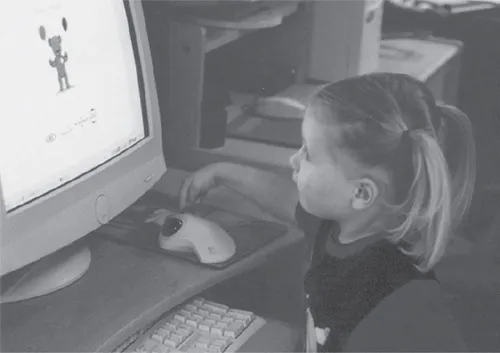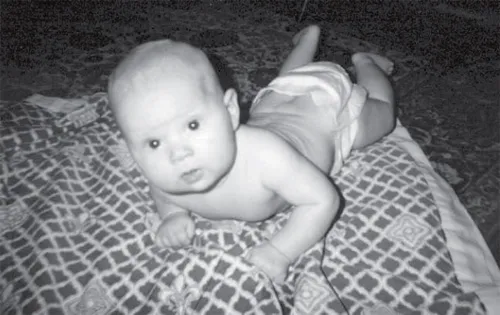![]()
1
Introduction
Greetings to our readers
- Do you look after a child or a group of children between birth and school entry?
- You may be studying for a vocational qualification in early childhood.
- Are you a nursery nurse, teaching assistant or a qualified teacher working with under-5s for the first time?
- Maybe you help out in a nursery or day care centre or preschool.
- You may be just thinking about being or doing one of these things.
If so, this book is for you.
Meet the authors
Laurie Makin is Director of the Children and Education Research Centre at the University of Newcastle in Australia. Laurie has published widely in the area of early literacy, and, in collaboration with colleagues, has produced a number of literacy-related resources for early childhood staff and students. She has two young grandchildren (one 5 years old, one 3 months old, at the time this book was written), so has been able to undertake a refresher course in developing young children’s literacy!
Marian Whitehead was formerly Senior Lecturer in Education at Goldsmiths College, University of London. She is the author of several standard texts on the development of language and literacy in the early years. Marian advises schools, care settings, training providers and various publications on ways of working with families and communities to support young children’s language and literacy learning. She has four grandchildren, the youngest is 3 and the oldest is 16. All of them have taught her about literacy and featured in her books and articles.
How this book is organised
There are seven chapters in this book. This introduction is the first. Chapters 2 to 5 review the literacy learning of children from birth to school entry. We take a chronological approach to children’s early literacy, starting with babies, then toddlers, pre-schoolers and, finally, children in transition to school. In each of these chapters, we look at ideas that will support children’s literacy learning and their positive dispositions towards literacy. We include ideas about setting up the environment, providing literacy resources and experiences, and interacting to promote literacy. In Chapter 6 we think about some of the issues in early literacy that need to be considered, whatever the age of the child. The issues we have chosen are:
- play and literacy;
- bilingualism and literacy;
- special needs and literacy;
- assessment of children’s literacy in the years prior to school entry and in transition to school;
- official curriculum frameworks outlining expectations relating to literacy.
The final chapter contains information on some additional resources that may be useful. We also include a list of references and an index to help you find information easily.
Throughout the book, we have tried to alternate gender pronouns (‘he’, ‘she’, and so on) when it seems necessary to refer to individual children.
Individual differences in literacy
Children are very different in their interests and levels of knowledge about literacy. They will have had many different literacy experiences in their homes and communities before they come to the early childhood setting. One 3-year-old may be reading already. One may be able to use a computer mouse and type her name. One may be totally uninterested in books. Another may love drawing and scribbling and painting. Good educators and carers recognise and respond positively to children’s differences. Here are some examples that show the wide range of differences in children’s interests and experiences.
Example 1: Two-year-old Dylan developed a passion for sharks after finding pictures of dozens of them on the inside covers (endpapers) of a storybook about a little boy who loved dinosaurs – until he saw a picture of a shark! All Dylan’s family and friends had to draw sharks for him and talk about them. He was taken to several big aquariums to see real sharks and friends and family collected leaflets and books about the many different kinds of sharks, which he could soon recognise and name. He also collected lots more storybooks about sharks, some bought for him and some borrowed from libraries. His bath-time toys soon included lots of plastic shark models and many a fearsome underwater struggle took place during his evening bath. Dylan at 2 years of age was helped by his family to become an ‘expert’ on sharks, in the way that many very young children become experts on trucks, dinosaurs, trains or chickens.
Example 2: Clair, between the ages of 4 and 5, became very interested in computers. Her parents both worked from home and used the computer frequently, so, like most children, Clair wanted to copy her parents. They encouraged a short time on the computer on most days, during which time they would show her something new and then let her explore freely, using her own CDROMS. By the time she was 5, Clair was quite knowledgeable about many aspects of computer use.
One day, she was pretending to be a magician and showing her uncle some magic tricks. When he complimented her on her ability, she replied, ‘If you want to know more, visit my website at www.magic.com.au.’ Clair didn’t have her own website, but she knew what they were, how they were used and the format in which they were presented.
1.1 Clair using the computer
Example 3: When she entered preschool, Satoko was a fluent speaker of Japanese and very interested in origami. She enjoyed making simple human and animal origami figures and making up stories about their adventures. When she started preschool, all of the other children spoke English and she was lost and unhappy for the first week or two. Satoko’s teacher talked with her parents, with the help of an interpreter, to find out what Satoko liked and was interested in. Knowing this, the teacher was able to introduce origami to all of the children and Satoko’s skill became a way in, helping her develop friendships with children who didn’t share her language or cultural background.
Example 4: Ben was born with a severe hearing disability. Luckily, this was diagnosed early, and his parents, who were not hearing-impaired, learned sign language as a way of communicating with Ben. When Ben was 3 years old, his mother had to return to work to supplement the family’s income. Ben’s parents worried a great deal about how he would get on in the long day at the care centre. With the help of local agencies, they were able to find a centre that had the assistance of a visiting teacher for the hearing-impaired. The educators at the centre decided that they wanted to help all of the children become aware of, and appreciate, different ways of communicating. One of the strategies they used was to make a class book of signs, which interested all the children and led to a wider exploration of non-verbal communication, including facial expression and body language.
All of these children are different from each other in their abilities, their interests and their experiences. The important thing for each of them, whatever their age, cultural background, language, or home and community experiences, is to be with early childhood educators who will find a match, or make links, between that child’s knowledge, skills, interests, abilities, and experiences, and the literacy learning environment of the educational setting.
We hope that this book will help you find such matches and links to facilitate children’s early literacy and learning, and that you will not hold too rigidly to an age–stage approach to learning.
Early literacy
Have you ever marvelled at how babies can make their wishes very clear, even without words?
In picture 1.2 Lilli (3 months) is screaming loudly. When her mother calls out, ‘It’s OK, Lilli, I’m coming’, her cry changes, even though she doesn’t understand what her mother is saying.
Have you heard young children’s creative use of language?
Clair (3 years 6 months) claims proudly, ‘Me gotted it!’
Have you seen the excitement when a child recognises the first letter of their name?
Whenever Morgan (2 years 5 months) sees the MacDonald’s sign, she shouts gleefully, ‘Look, Mum, that’s my letter. We got to get a burger.’
(Makin and Whiteman, 2002)
1.2 Lilli hears mum’s voice
Has a child ever shown you proudly a page on which they have scribbled, and said,
‘Look what I writed’?
Have you seen a child show you they understand that there is a relationship between pictures on a page and real-life objects?
When his father is reading to Kyle, they come to a picture of a ball. Kyle (14 months) jumps off his father’s lap, goes and finds his own ball and brings it back to Dad.
Have you been surprised and perhaps embarrassed to find that a young child knows more about technology than you do?
Manny (3 years) picks out his favourite video and puts it in the machine. His older brother (8 years) is the only one in the family who can programme the video!
If you are interested in these things and want to know how to support young children in their literacy learning, this book is for you!
A quiz to try
Try this short quiz. Answer yes or no to each of the statements:
What I think about literacy
- Literacy is reading and writing.
- Literacy isn’t like it used to be.
- Literacy starts when children go to school.
- Literacy starts when children are born.
- Children’s scribbles are important.
- Children’s life opportunities will be related to their literacy.
Let’s look at each of these in turn
- Literacy means reading and writing. The answer here is both yes and no. Yes, literacy is reading and writing, but it is now considered to be more than this. Literacy now includes non-verbal communication – gestures and sounds and body language. It includes listening and talking as well as reading and writin...


